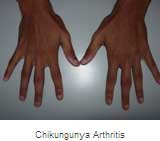
Chikungunya arthritis is endemic in Maharashtra and other states of India since 2006. It is caused by the Chikungunya virus. Just as the virus causes sneezing cold due to swelling inside the nose, the Chikungunya virus causes joint pain due to swelling inside joints. Chikungunya virus was initially isolated in 1953 at Makonde plateau (Tanzania) along the border of Tanzania and Mozambique. The word Chikungunya implies 'a disease which bends up' in the Makonde language. Chikungunya virus spreads via Aedes aegypti mosquitoes which breed on clear water and bite during the daytime. This mosquito bites many people for a single meal, thus infecting many people in a short time. These mosquitoes also spread diseases such as dengue, yellow fever (jaundice), and filariasis.
Fever, crippling joint pains, and stiffness all over the body are the main features. Joints of hands and feet, including wrists and ankles, are commonly involved. The pain, usually lasting for a week or so, improves with activity but worsens after strenuous exertion. However, in some cases, joint pains may require months to resolve completely. Arthritis may persist and become chronic in about 12% of cases. Prolonged joint pain is particularly troublesome in elderly patients and those with other forms of arthritis, heart disease, or hemiplegia. Minor itchy skin rashes may appear but are less evident in Indian patients. Headache, redness of eyes, muscle pains, back pain, sore throat, and severe fatigue may occur in some patients. Some cases can develop complications in the form of involvement of kidneys and the nervous system. A few deaths have also been reported.
No tests are required in a typical case occurring in an endemic area. However, special blood tests can show IgM antibodies for two to four months. However, this report can be false positive or false negative. Rheumatoid factor may be positive in low titers. Many other viruses such as hepatitis, HIV, mumps, and Rubella also cause arthritis.
The late phase of Chikungunya is an immune-mediated reaction triggered by the virus. Persistent joint pains and arthritis characterize it in over 74% of cases. Skin lesions, headache, insomnia, and fatigue persist in 3-7% of cases. Patients with severe and prolonged (>30 days) initial joint symptoms require more time to recover. Rheumatic symptoms are mild in most cases and can be fluctuating or constant. Chronic arthritis involves more than four joints in 76% of cases. It usually affects ankles, knees, wrists, and small joints of toes and fingers. Female sex, obesity, Chik V IgG positivity, lower education level, and presence of osteoarthritis are risk factors for chronic sequelae. Rest during the acute phase does not prevent the development of late complications. Severe and unusual forms of arthralgias have also been observed. Tendonitis, bursitis, and enthesitis can also occur. These features persist for more than 30 days and lead to catastrophic health expenditure (lost workdays and out-of-pocket expenses). Some studies indicate the persistence of arthritis for 15-20 months to 3-5 years. Erosive arthritis and the triggering of rheumatoid arthritis have also been reported. A symmetric polyarthritis of more than six weeks duration can be easily mistaken for rheumatoid arthritis.
Adequate rest, ample fluids, light exercise, and painkillers are advised in all cases of acute arthritis. Steroids in small doses offer better pain control. Chronic Chikungunya arthritis requires expert care with various disease-modifying drugs. One attack of Chikungunya infection confers lifetime immunity against the virus. Treatment of the late phase is similar to rheumatoid arthritis. However, medications may be required in lower doses and for a shorter duration.
Prevention mosquito bites by wearing full pants and full sleeves and using mosquito repellents during the daytime are essential measures. Instructions from local authorities must be strictly followed. Observance of a dry day once a week is helpful. Water-holding containers such as tins, cans, empty pots, flower vases, discarded rubber tyres, broken bottles, coconut shells, and similar items must be destroyed or cleaned and dried up. Control of larvae and adult mosquitoes using appropriate insecticides and maintaining a clean surrounding is also essential.
